Accepted Scientific Name: Echinocereus engelmannii (Parry ex Engelm.) Lem.
Cactées 56. 1868
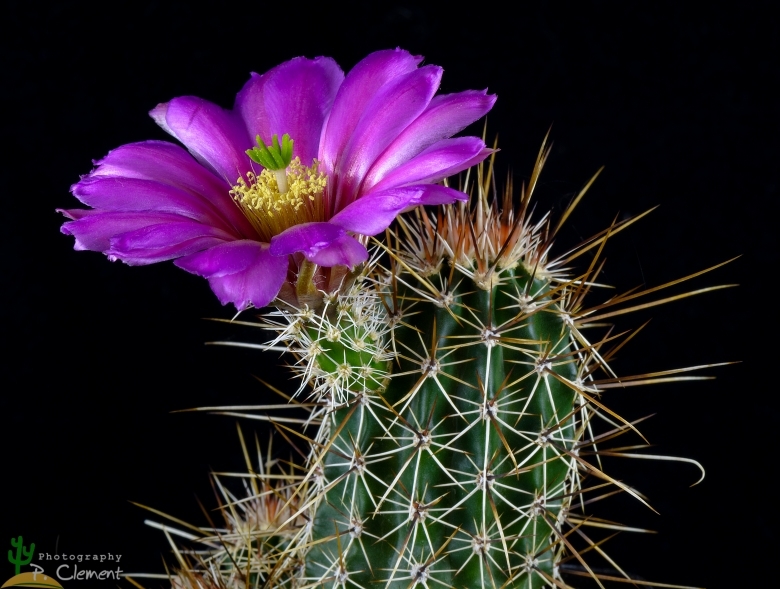
Echinocereus engelmannii var. variegatus Photo by: Peiffer Clement
Origin and Habitat: Arizona (Mojave County to House Rock Valley and the Navajo Bridge, mainly not of the Colorado canyons), USA.
Type locality: Head of Bill Williams River, Mojave County.
Altitude range: 1,080 to 1,705 metres above sea level.
Habit and ecology: This species dwells in desert soils and grasslands.
Synonyms:
See all synonyms of Echinocereus engelmannii
Common Names include:
ENGLISH: Torch Cactus, Saint Cactus, Hedgehog Cactus, Strawberry Hedgehog Cactus, Engelmann’s Hedgehog Cactus
Description: Echinocereus engelmannii var. variegatusSN|7982]]SN|7982]] is a local or morphological form of the widespread and variable Echinocereus engelmannii. It differs from the type variety mainly for its lowermost central spines mainly 2.8-4.5 cm long, often markedly differing in colour from other spines and varying from white to brown often mottled with black. However the distinguishing characteristics of Echinocereus engelmannii var. variegatusSN|7982]]SN|7982]], appear to fall within the natural variation of Echinocereus engelmannii and it should be synonymized with the latter, but it still has a value for a collector because they identify plants with particular characters.
Derivation of specific name: 'variegatus' Lat., mottled, variegated; for the variable spine colours.
Habit: Echinocereus engelmannii var. variegatusSN|7982]]SN|7982]] is a small mound-forming cactus with nearly black clusters of 2 to 12 erect stems.
Stems: Sark green 10 to 20 cm tall, 2 to 5.5 cm in diameter.
Spines: Highly variegated (variable) in colour, being either white, horn-colored, dark-red or black; lower central 3.75 cm long, straight, stiff; other centrals shorter, darker in colour. The three upper centrals often curved.
Flowers: varied in colour from pink to purple to magenta. 5 cm (2 inches) in diameter, 5 cm (2 inches) long.
Blooming season. Spring (April).
Fruits: Spiny, 3.75 cm long, red when ripe.
Seeds: c. 4 mm wide, black.
Subspecies, varieties, forms and cultivars of plants belonging to the Echinocereus engelmannii group
 Echinocereus engelmannii (Parry ex Engelm.) Lem.: ( var. engelmannii) ha 4 to 6 central spines whitish, golden-yellow, reddish brown to nearly black. It is a highly variable species. Distribution: Southwestern USA (California, Nevada, and Arizona) and northwestern Mexico (Baja California and Sonora).
Echinocereus engelmannii (Parry ex Engelm.) Lem.: ( var. engelmannii) ha 4 to 6 central spines whitish, golden-yellow, reddish brown to nearly black. It is a highly variable species. Distribution: Southwestern USA (California, Nevada, and Arizona) and northwestern Mexico (Baja California and Sonora). Echinocereus engelmannii var. acicularis L.D.Benson in L.D.Benson: has only 2-4 central spines and more robust habit. Distribution: California, Arizona, Baja California and Sonora.
Echinocereus engelmannii var. acicularis L.D.Benson in L.D.Benson: has only 2-4 central spines and more robust habit. Distribution: California, Arizona, Baja California and Sonora. Echinocereus engelmannii var. armatus L.D.Benson: is the most formidably spiny extreme of the species, central spines up to 13 cm long. Distribution: California and Nevada.
Echinocereus engelmannii var. armatus L.D.Benson: is the most formidably spiny extreme of the species, central spines up to 13 cm long. Distribution: California and Nevada. Echinocereus engelmannii var. chrysocentrus (Engelm. & J.M.Bigelow) Rümpler in C.F.Först.: has 5-6 very stout yellowish to brown central spines, up to 7 cm long (or more), but it is very variable. Distribution: California, Nevada, Arizona, and Utah.
Echinocereus engelmannii var. chrysocentrus (Engelm. & J.M.Bigelow) Rümpler in C.F.Först.: has 5-6 very stout yellowish to brown central spines, up to 7 cm long (or more), but it is very variable. Distribution: California, Nevada, Arizona, and Utah.- Echinocereus engelmannii var. howei L.D.Benson: Distribution: California and Nevada.
 Echinocereus engelmannii var. munzii (Parish) W.Pierce & Fosberg: is a mountain form with white spines twisting up up from small bodies, with 4 central spines (except in an occasional areole) instead of 1 and magenta flowers. Distribution: California and Baja California.
Echinocereus engelmannii var. munzii (Parish) W.Pierce & Fosberg: is a mountain form with white spines twisting up up from small bodies, with 4 central spines (except in an occasional areole) instead of 1 and magenta flowers. Distribution: California and Baja California. Echinocereus engelmannii var. purpureus L.D.Benson: is a dark-colored, short-spined morphological form that occurs interspersed throughout populations of Echinocereus engelmannii var. chrysocentrus. Distribution: Utah.
Echinocereus engelmannii var. purpureus L.D.Benson: is a dark-colored, short-spined morphological form that occurs interspersed throughout populations of Echinocereus engelmannii var. chrysocentrus. Distribution: Utah. Echinocereus engelmannii var. variegatus (Engelm. & J.M.Bigelow) Rümpler in C.F.Först.: has multicoloured dark-colored spines, typically the central spines are long red or black and contrasts nicely with the white radial spines. Distribution: Arizona and Utah.
Echinocereus engelmannii var. variegatus (Engelm. & J.M.Bigelow) Rümpler in C.F.Först.: has multicoloured dark-colored spines, typically the central spines are long red or black and contrasts nicely with the white radial spines. Distribution: Arizona and Utah.
Bibliography: Major references and further lectures:
1) W. Hubert Earle “Cacti of the Southwest” Rancho Arroyo Book, 1986
2) Urs Eggli, Leonard E. Newton “Etymological Dictionary of Succulent Plant Names” Springer Science & Business Media, 29 June 2013
3) "Great Basin Naturalist Memoirs", 9 Ed. Brigham Young University, 1987
4) Denny Rodgers “Liberty Hyde Bailey: A Story of American Plant Sciences”, Volume 2 Princeton University Press, 1949
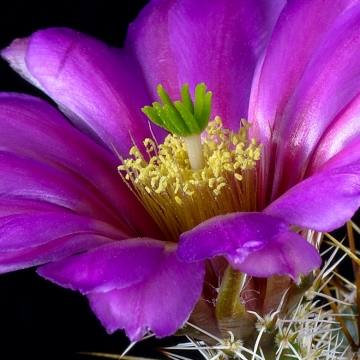 Echinocereus engelmannii var. variegatus Photo by: Peiffer Clement
Echinocereus engelmannii var. variegatus Photo by: Peiffer Clement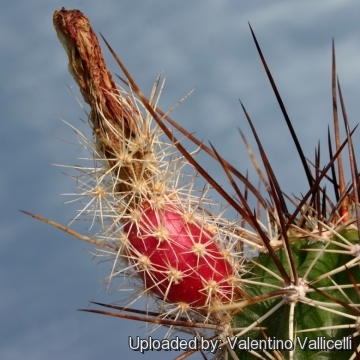 Echinocereus engelmannii var. variegatus Photo by: Valentino Vallicelli
Echinocereus engelmannii var. variegatus Photo by: Valentino Vallicelli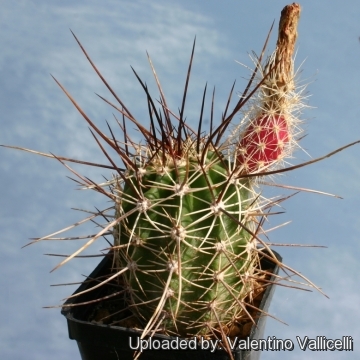 Echinocereus engelmannii var. variegatus Photo by: Valentino Vallicelli
Echinocereus engelmannii var. variegatus Photo by: Valentino Vallicelli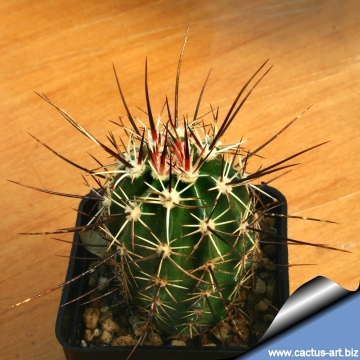 Echinocereus engelmannii var. variegatus Photo by: Cactus Art
Echinocereus engelmannii var. variegatus Photo by: Cactus ArtCultivation and Propagation: Echinocereus engelmannii var. variegatusSN|7982]]SN|7982]] grows rather slowly and it is sensitive to overwatering (rot prone) and needs a very good drainage to avoid rotting, but requires more moisture than true desert cacti to grow and produce flower.














